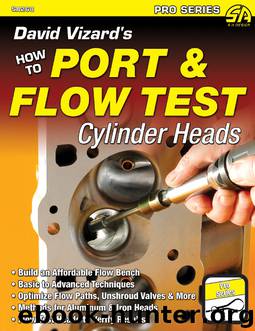David Vizard's How to Port & Flow Test Cylinder Heads by David Vizard

Author:David Vizard [Vizard, David]
Format: epub
ISBN: 9781613250952
Publisher: SA Design
Valve Seat Forms
The more rounded and streamlined a seat and the approach and departure areas are, the more efficiently it’s likely to flow. Figure 8.5 shows about how much the average flow efficiency of the first 0.250-inch lift of an approximately 2-inch-diameter valve varies with seat design. Although a hypothetical knife-edge valve seat as on cylinder number-1 gives the largest throat area, note that its efficiency is pathetically low at 45 percent. Number-2 is really the first seat that can actually be used, and at best this is 56 percent efficient.
By streamlining the underside of the 45-degree seat, the situation is further improved when a 30-degree top cut is applied as on number-4. For number-5, a surface is present to constrain at least one side of the jet of air/fuel as it enters the cylinder (or exits for the exhaust). With suitable attention to detail, the flow efficiency of an intake valve in the first 0.100 to 0.150 inch can closely approach 100 percent while the exhaust, at higher lift values, can actually exceed 100 percent by virtue of nozzling. That is, the seat and port is starting to emulate a nozzle similar to a venturi of a rocket nozzle. All this only comes about by virtue of a well-developed form before and after the seat.
Download
This site does not store any files on its server. We only index and link to content provided by other sites. Please contact the content providers to delete copyright contents if any and email us, we'll remove relevant links or contents immediately.
| Automotive | Engineering |
| Transportation |
Machine Learning at Scale with H2O by Gregory Keys | David Whiting(3957)
Never by Ken Follett(3701)
Urban Outlaw by Magnus Walker(3303)
OPNsense Beginner to Professional by Julio Cesar Bueno de Camargo(3226)
Sapiens and Homo Deus by Yuval Noah Harari(2940)
Will by Will Smith(2732)
A Short History of Nearly Everything by Bryson Bill(2577)
Hooked: A Dark, Contemporary Romance (Never After Series) by Emily McIntire(2462)
Rationality by Steven Pinker(2226)
Borders by unknow(2143)
Holy Bible (NIV) by Zondervan(2054)
The Becoming by Nora Roberts(2027)
The One Percenter Encyclopedia by Bill Hayes(1752)
Freedom by Sonny Barger(1741)
HBR's 10 Must Reads 2022 by Harvard Business Review(1736)
A Short History of War by Jeremy Black(1724)
Five Ways to Fall by K.A. Tucker(1665)
Girls Auto Clinic Glove Box Guide by Patrice Banks(1653)
Go Tell the Bees That I Am Gone by Diana Gabaldon(1643)
